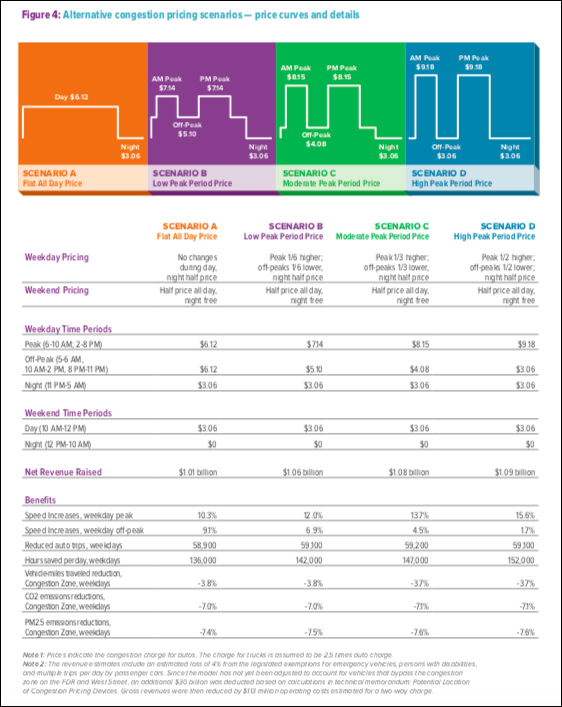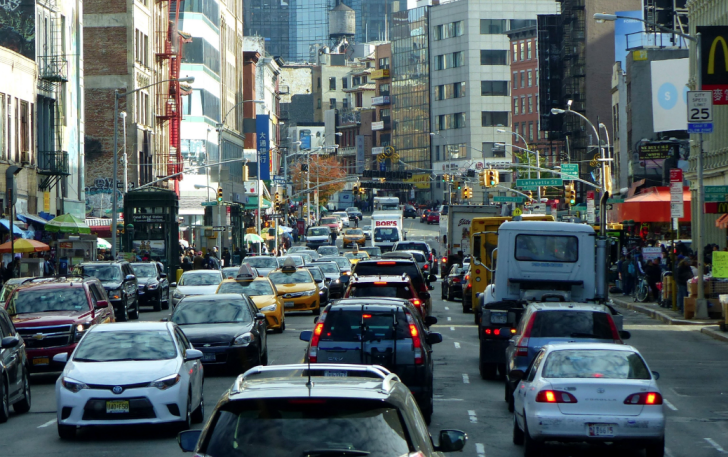The cost to drive a car into the central business district of Manhattan must be really, really high — and the tolling fees should apply in both directions, a new report by a major regional transportation group suggests.
The study by the Regional Plan Association does not make specific pricing recommendations for the coming congestion fee, but its analysis of potential tolls reveals that a high fee — a peak-period toll of $9.18 to get into Manhattan below 60th Street and the same $9.18 rush-hour fee to get out — would provide greater benefits than lower fees.
"If implemented properly, congestion pricing will be groundbreaking," argues the report, which was issued today [PDF]. "It will allow us to unclog our streets, improve quality of life and health, help meet state clean air goals, and raise much-needed revenue for our public transportation system. And it will set a model for other cities across the country and world struggling with congestion, air pollution, and aging infrastructure."

Of course, the term "implemented properly" depends on one's perspective. All of the pricing schemes analyzed by the report raise the required $1 billion in annual funding mandated when the state legislature passed congestion pricing earlier this year. But the higher the fee, the better the benefits.
It's all laid out in the four scenarios in the chart to the right:
- A low, $6.12 "flat, all-day price," for example, would raise the least revenue ($1.01 billion) and decrease rush-hour traffic least effectively. But it would improve off-peak traffic better than the other plans because the flat fee remains in place even during off-peak hours.
- Meanwhile, the two mid-priced scenarios (one-way peak fees of $7.14 and $8.15 with different off-peak rates) raise more revenue for transit than the flat fee, and do help ease rush-hour congestion more.
- But the best overall package appears to be the highest fee: At $9.18 each way, the congestion toll would raise the most revenue ($1.06 billion) and increase traffic speeds by the biggest amount (15.6 percent). This scenario, however, does little to alter off-peak travel times, but a chief goal of congestion pricing is to reduce congestion during the times when it is worse — namely, during rush hours.
The RPA analysis relies on Charles Komanoff's famed "Balanced Transportation Analyzer" spreadsheet, which provides the statistical underpinning for the different models. Komanoff said he supports the idea of two-way congestion tolling.
"Two-way tolling isn't essential to congestion pricing's success, but it would be almost crazy not to do it," he told Streetsblog. "Even if it only generates the same revenue, two-way tolling will be more fair, more traffic-smoothing and more pro-environment than one-way.
"Two-way tolls will also be better at driving home the idea underlying congestion pricing: that every use of a car or truck should be charged for at least some of the general slowing-down caused by that use," Komanoff added. "Paying, say, five times more for an inbound peak trip than for an outbound off-peak trip will convey that message in a uniquely powerful way."
Also, two-way tolling reduces the practice of "bridge shopping," which results from some bridges being free for drivers, while others are not.
"The two-way approach provides sufficient additional benefits to justify the higher cost," the RPA report said. "A one-way congestion charge [would] potentially create new toll shopping. Drivers would have a cost incentive to take the Hugh Carey Tunnel or RFK Bridge on the way in, and the currently free bridges on the way out, leading to more vehicle miles traveled and greater congestion, particularly at the lower-priced points of entry and exit."
The RPA also likes two-way tolling because it provides more flexibility.
"It gives you a better ability to address differences in the morning and afternoon peak," said Kate Slevin, a senior VP of the regional group. "The evening peak may last a longer time, so you can target the toll to address that and further reduce congestion."
All of the four scenarios take into account a proposed credit for drivers who pay a toll — such as in the Queens-Midtown, Holland or Lincoln tunnel — to get directly into the congestion zone. All of the revenue projections, however, would drop if that toll credit was extended to drivers who pay a toll to enter Manhattan — say over the Henry Hudson Bridge — and then continue into the zone.
Crediting those drivers would require eight- to 12-percent higher congestion pricing tolls in order to maintain the revenue projections.
The RPA did not stake out a position on what plan is best. It is unlikely that policymakers will set the congestion pricing fee as high as the $9.18 each-way scenario.
"For every exemption, someone else has to pay more," Slevin said. "This report is meant to simply lay out all the pros and cons of the scenarios."
Komanoff wasn't pleased by the association's refusal to condemn credits for tolls outside the congestion zone.
"Holding open door for possible upstream toll credits is not helpful," he said.
One thing that often gets lost in the shuffle in the discussion of congestion pricing is that even at $9.18 each way during the peak hours, congestion tolls are still too low to truly discourage driving. For instance, even with that high fee, a couple in Westchester can drive into Manhattan — say to take in a show! — for far less than it would cost them to take Metro-North. But the highest fee would at least provide an incentive, said Ben Fried of TransitCenter.
"The congestion fee will change drivers' calculations in the right direction," Fried said. "The higher peak-hour rate will move it the most. It's the best plan."
Read the report for yourself here.






